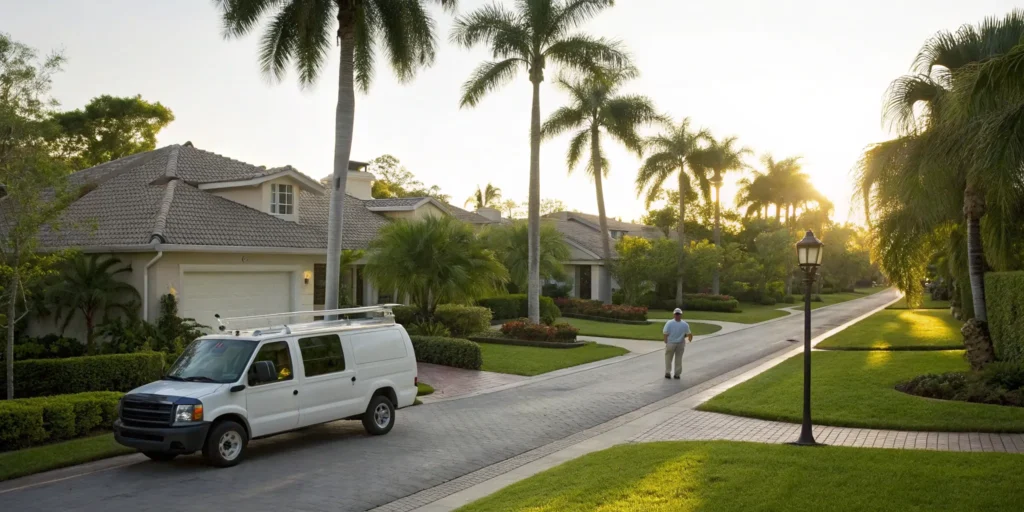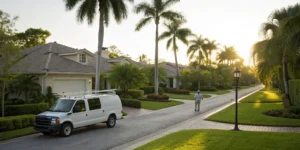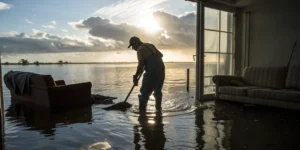Introduction
The sound of dripping water is one thing, but discovering a spreading pool of it in your home is a heart-stopping moment. In that initial panic, the first instinct is to clean it up. But before you grab the mop, it’s vital to understand that not all water is created equal.
The water in your home might look clean, but it could be teeming with hidden dangers. Treating all water damage the same is a serious risk to your family’s health. What appears to be harmless at first glance could actually harbor bacteria, viruses, and toxins that pose significant health threats.
In this guide, we’ll walk you through the three official categories of water—Clean Water, Grey Water, and the hazardous Black Water—to empower you with the knowledge to protect what matters most. Understanding these distinctions can mean the difference between a manageable cleanup and a dangerous health emergency.
Category 1: “Clean Water” – Not as Harmless as It Seems
What is Category 1 Water?
Category 1 water originates from a sanitary source and does not pose a substantial threat from dermal, ingestion, or inhalation exposure. At the time of initial contact, this water is considered safe and poses minimal risk to human health.
Common Sources of Clean Water
- Broken water supply lines: When pipes carrying fresh water rupture or leak
- Malfunctioning appliances: Water heaters, ice makers, or other devices connected directly to a supply line
- Overflowing bathtubs or sinks: When filled with clean water and no contaminants are present
- Melting snow or falling rainwater: Fresh precipitation that hasn’t made contact with contaminated surfaces
The Hidden Danger: Time is the Enemy
While initially clean, Category 1 water can quickly become contaminated—and this is where many homeowners make critical mistakes. The clock starts ticking the moment water enters your home.
When clean water comes into contact with building materials like drywall, insulation, and carpet, it begins absorbing microbes, dirt, and organic matter. Within just 24 to 48 hours, that pristine water can degrade into Category 2. Building materials provide the perfect breeding ground for bacterial growth, and warm, moist conditions accelerate the process. This is the window where mold growth begins, often invisibly within walls and under flooring. What started as a simple supply line break can transform into a serious contamination issue if not addressed immediately.
Category 2: “Grey Water” – Handle with Significant Caution
What is Category 2 Water?
Category 2 water is significantly contaminated and has the potential to cause discomfort or sickness if consumed or contacted by humans. This water contains chemical, biological, or physical contaminants that elevate the risk level considerably beyond Category 1.
Common Sources of Grey Water
- Overflowing washing machines or dishwashers: Water mixed with detergents, food particles, and other household substances
- Toilet overflows containing only urine: Without fecal matter present
- Sump pump failures: Allowing groundwater to enter basements
- Water from hydrostatic pressure: Seeping into basements through foundation cracks and walls
The Clear Health Hazards
Grey water isn’t something you want to handle casually. It contains chemical, biological, or physical contaminants that can make you sick. The soap residue from washing machines might seem harmless, but combined with bacteria from clothing, skin cells, and other organic matter, grey water becomes a genuine health concern.
Specific threats include bacteria like Staphylococcus and Streptococcus, along with various viruses that can lead to gastrointestinal illness, skin infections, and respiratory problems. Anyone handling grey water should wear personal protective equipment (PPE) including gloves, eye protection, and appropriate clothing. Children and those with compromised immune systems should be kept far away from affected areas. Professional assessment is strongly recommended, as what appears to be a minor issue can harbor significant health risks.
Category 3: “Black Water” – A Serious Biohazard Emergency
What is Category 3 Water?
Category 3 water is grossly unsanitary and contains pathogenic agents. It can cause severe illness or even death if ingested. All direct contact should be avoided. This is not water to be taken lightly—it’s a genuine biohazard that requires professional intervention.
Common (and Frightening) Sources of Black Water
This section is crucial because many people underestimate which water sources qualify as Category 3:
- Sewage backups: From toilets containing feces, main sewer lines, or septic system failures
- All river and stream flooding: This is a key point many overlook. Floodwater from outside sources picks up everything in its path—sewage, chemicals, animal waste, and industrial contaminants
- Seawater and storm surges: From hurricanes, typhoons, and coastal flooding events
- Stagnant water: Any water, even if it originated from a clean source, that has been standing for more than 72 hours and has supported microbial growth
The Severe Health Risks You Cannot Ignore
Category 3 water is a toxic soup of dangerous pathogens and contaminants. Understanding what lurks in black water helps you grasp why professional remediation is non-negotiable.
Bacteria: E. coli causes severe gastrointestinal distress and can lead to kidney failure. Salmonella brings fever, diarrhea, and abdominal cramps. Listeria is particularly dangerous for pregnant women and can cause miscarriage or stillbirth.
Viruses: Hepatitis A attacks the liver and spreads easily through contaminated water. Rotavirus and Norovirus cause severe vomiting and diarrhea that can lead to dangerous dehydration, especially in children and elderly individuals.
Parasites: Giardia causes prolonged intestinal illness with chronic diarrhea. Cryptosporidium is resistant to standard disinfection and can be life-threatening for those with weakened immune systems.
Chemicals: Pesticides from agricultural runoff, heavy metals like lead and mercury, and industrial waste from urban and suburban ground contamination all concentrate in floodwater.
Critical Warning: Category 3 water and any materials it has touched—drywall, carpet, furniture, insulation—must be handled by certified professionals with specialized equipment. This includes proper containment, air filtration systems, antimicrobial treatments, and safe disposal protocols. Do not attempt to clean this yourself. The health risks are too severe, and improper cleanup can spread contamination throughout your home.
A Quick Guide: When in Doubt, Assume the Worst
Here’s the most important safety principle you need to remember: water can look perfectly clear yet be Category 3. The absence of visible debris, odor, or discoloration does not guarantee safety. Harmful pathogens are microscopic and odorless.
The simple rule: If you cannot be 100% certain of the water’s source and cleanliness, treat it as a biohazard. Your family’s health is not worth the risk. It’s far better to be overly cautious and call professionals than to expose yourself and your loved ones to invisible dangers. When uncertainty exists, err on the side of safety every single time.
Finding Peace in the Midst of Chaos
Discovering a flood can feel overwhelming—a true test of our peace and resilience. The immediate shock, the racing thoughts about damage and cost, the worry about your family’s safety—these emotions are completely natural and valid.
In these moments, it’s important to pause, take a safe step back, and remember that your home is bricks and mortar, but your family is everything. Possessions can be replaced. Structures can be rebuilt. What cannot be replaced is your health and the wellbeing of those you love.
This is a challenge, but you have the strength to navigate it wisely. By educating yourself about the real risks and taking measured, informed action, you’re already protecting your family in the most important way. Knowledge brings clarity, and clarity brings calm even in crisis. You’re not helpless—you’re empowered to make the right decisions.
Your Immediate Safety Steps
When you discover water damage, follow these steps in order:
- Stop the Water Source (If Safe): Only if you can do so without walking through standing water. If the shutoff requires entering the affected area, skip to step two and call for help.
- Turn Off the Electricity: Immediately shut off the circuit breaker to the affected area. Water and electricity are a deadly combination. If your electrical panel is in the flooded area, do not approach it—call your utility company or emergency services.
- Evacuate the Area: Keep children and pets far away from the affected zone. Establish a clear boundary and ensure everyone in the household understands not to enter.
- Avoid All Contact: Especially with Category 2 or 3 water. Do not attempt to use a household vacuum to remove water, as this can spread contamination and damage your equipment. Do not walk through the water unnecessarily.
- Document the Damage: If it’s safe to do so from a distance, take photos and videos for insurance purposes. Do not enter unsafe areas for documentation.
- Call a Certified Professional: Professional water mitigation and restoration is not a luxury—it’s a necessity for health and safety, especially with Grey or Black water. Professionals have the training, equipment, and protocols to safely assess, contain, and remediate water damage while protecting your family’s health.
Protecting Your Home Starts with Protecting Your Health
Understanding the three categories of water—Clean, Grey, and Black—is the first step in a safe recovery from water damage. Each category carries its own distinct risks, and those risks escalate quickly with time and contamination.
The most serious dangers from floodwater are often the ones you can’t see. Pathogens don’t announce themselves with odors or visible signs. Contamination doesn’t wait for you to assess the situation. By the time symptoms appear, exposure has already occurred. This is why immediate professional assessment is so critical.
Your home can be restored. Your health, once compromised, may take much longer to recover—or in severe cases, may result in permanent damage. Make the wise choice to prioritize safety over speed, professional help over DIY attempts, and caution over assumption.
If you’re facing water damage and are unsure of the source, don’t leave your health to chance. Contact a certified water damage restoration team 24/7 for an immediate and safe assessment. Your family’s wellbeing is worth the call.
Frequently Asked Questions About Flood Damage and Water Damage Restoration
Q1: How quickly does Clean Water (Category 1) degrade to Grey Water (Category 2)?
Clean water can degrade to Category 2 in as little as 24 to 48 hours after coming into contact with building materials. The exact timeline depends on temperature, humidity, and the materials involved. Porous materials like carpet, drywall, and insulation accelerate the degradation process. This is why immediate action is crucial for both residential and commercial properties—the window for safe cleanup is extremely narrow. Professional water damage restoration services can assess the contamination level and restore your property before further degradation occurs.
Q2: Is rainwater from a storm considered Black Water?
It depends on the source and what the water has contacted. Fresh rainwater falling directly from the sky and collected in a clean container is Category 1. However, rainwater that has flowed across roofs, gutters, streets, or ground surfaces typically becomes Category 2 due to contamination from bird droppings, chemicals, dirt, and organic matter. Storm flooding that includes river or stream overflow, or standing water from urban areas, is always Category 3 due to sewage contamination and hazardous runoff. Commercial properties are particularly vulnerable to flood damage from contaminated stormwater due to larger roof systems and parking areas that collect debris and pollutants.
Q3: Can I clean up Black Water myself with bleach?
Absolutely not. While bleach is a disinfectant, it cannot make Category 3 water cleanup safe for untrained individuals. Black water contains multiple types of pathogens, many of which are resistant to household cleaning products. Professional water damage restoration requires specialized equipment including industrial-grade antimicrobials, air scrubbers with HEPA filtration, negative air pressure systems to prevent contamination spread, and proper disposal protocols for contaminated materials. Additionally, any porous materials that contacted Black Water—including drywall, insulation, carpet, and padding—must be completely removed and cannot be salvaged. Whether for your home or business, professional intervention is essential to properly restore the affected areas and ensure the safety of occupants.
Q4: What are the signs of mould growth after water damage?
Visible signs include dark spots or patches on walls, ceilings, or floors, often black, green, or brown in color. You might notice a musty, earthy odor even when no visible mould is present—this often indicates hidden growth behind walls or under flooring. Physical symptoms in occupants can also signal mould: increased allergies, respiratory issues, persistent coughing, eye irritation, or unexplained headaches that improve when away from the property. Peeling wallpaper, bubbling paint, or warping baseboards can indicate moisture problems and potential mould growth. Remember that mould can begin growing within 24 to 48 hours of water exposure, and it often thrives in hidden spaces. If you suspect mould in your home or commercial property, professional testing and remediation are essential—disturbing mould without proper containment spreads spores throughout the building.
Q5: How does flood damage affect commercial properties differently than homes?
Commercial properties face unique challenges with flood damage due to their larger square footage, complex HVAC systems that can spread contamination, sensitive equipment and inventory, and business interruption costs. Water damage restoration for commercial spaces requires rapid response to minimize downtime and financial losses. Professional restoration companies understand that every hour your business is closed impacts revenue, employee productivity, and customer relationships. Commercial flood damage often requires 24/7 restoration work, coordination with insurance adjusters, and specialized techniques to restore everything from office spaces to warehouses. Additionally, businesses must comply with health and safety regulations, making professional restoration services critical to ensure your facility meets all regulatory requirements before reopening.
Q6: What should I do immediately after discovering flood damage?
For both residential and commercial properties, immediate action is critical. First, ensure safety by turning off electricity if it’s safe to do so and evacuating if there’s any risk. Document the damage with photos and videos for insurance purposes. Contact a professional water damage restoration company immediately—restoration experts available 24/7 can begin emergency services within hours. Do not attempt to remove standing water yourself if it may be contaminated. For businesses, notify your insurance company and key stakeholders about the flood damage and potential operational impact. Professional restoration teams will assess the water category, extract standing water, begin drying and dehumidification, and create a comprehensive plan to restore your property quickly and safely. Early intervention prevents mould growth, reduces structural damage, and significantly lowers overall restoration costs.
Get The Best Flood Restoration Services
Don’t face water damage alone. SuperClean Restoration Services provides 24/7 emergency response for all categories of water damage—from clean water leaks to hazardous black water floods. Our certified professionals have the specialized equipment and expertise to safely assess, contain, and restore your property while protecting your family’s health. Contact us today.
Call Us 24/7 for Emergency Water Damage Restoration: 844-888-0837




